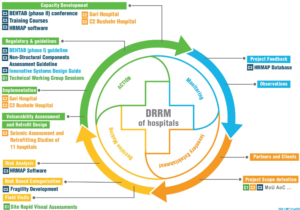BEHTAB Phase-II Concept, An Integrated DRRM Approach
BEHTAB-phase II Project, as an emergency support project, was defined from a Disaster Risk Reduction Management (DRRM) perspective. In this framework, every decision is made for how to face the existing risk and determine the necessary measures for this purpose based on risk analysis and identification studies. Disaster Risk Reduction and Management is classically carried out in two parts:
- Risk analysis and identification: At this stage, studies are necessary to identify the inventory and exposure. It will result in a list of at-risk asset’s components, their value and importance, hazard intensity and vulnerability of each component in the inventory, and finally the amount of probable loss. In addition, factors causing damage to each component are identified as well as for the entire asset. Obviously, the amount of the loss depends on the point of view of the client and the agent of this stage.
- Risk treatment: At this stage the necessary measures are taken to reduce the risk, according to the prioritization based on results of the previous stage and the investigation of factors causing vulnerability and damages. A Risk Reduction Plan containing various necessary measures to reduce the risk is defined and implemented. These actions include one or more of the following: Improving the physical conditions of the desired component, improving readiness and developing institutional and human capacity in the organizational complex, risk transfer with the help of financial instruments such as disaster insurance, etc. It is necessary at this stage, to define the role and position of stakeholders in the process of risk reduction program, considering all beneficiaries.
All activities of the BEHTAB phase II Project are aimed to be aligned with this context and can be categorized as one of the main aspects of a DRRM project. By putting the results together, it was intended to finally provide a practical toolbox along with the experience of the pilot project in hospital risk management to the beneficiaries/stakeholders of this project.


